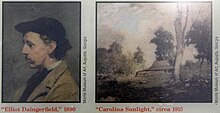HD 174179
HD 174179| 관측 데이터 신기루 J2000.0 이쿼녹스 J2000.0 | |
|---|---|
| 별자리 | 리라 |
| 우측 상승 | 18h 46m 13.01070s[1] |
| 탈위임 | +41° 26′ 30.5041″[1] |
| 겉보기 크기 (V) | 6.06[2] |
| 특성. | |
| 스펙트럼형 | B3IVP[3][4] |
| B-V색지수 | −0.139±0.003[2] |
| 아스트로메트리 | |
| 방사 속도 (Rv) | -15.0±2.9km[2]/s |
| 고유 운동 (μ) | RA: +1.093[1]mas/yr Dec.: −3.957[1]mas/yr |
| 시차 (π) | 2.5407 ± 0.0769[1] 마스 |
| 거리 | 1,210 ± 40 ly (102 ± 10 pc) |
| 절대치수 (MV) | −1.57[2] |
| 세부 사항 | |
| 미사 | 6.6±0.1[4] M☉ |
| 루미도(골수계) | 2,036[5] L☉ |
| 온도 | 17,900K[5] |
| 회전 속도 (v sin i) | 5km[6]/s |
| 나이 | 32.8±5.0[4] 마이어 |
| 기타 지정 | |
| 데이터베이스 참조 | |
| 심바드 | 자료 |
HD 174179는 라이라 북쪽 별자리에 있는 단일 별이다[8].흰색 빛깔을 띠며 육안으로는 6.06의 외관상으로 희미하게 보인다.[2]이 별은 시차를 기준으로 태양으로부터 약 1,280광년 거리에 위치하지만 방사상 속도 -15 km/s로 더 가까이 표류하고 있다.[1][2]
이 별은 약 3300만년[4] 된 것으로 추정되며, 5km/s의 낮은 예상 회전 속도를 가지고 있다.[6]태양 질량의 6.6배를[4] 가지고 있으며 광권으로부터 태양 광도의 2,036배를[5] 유효온도 17,900K로 방사하고 있다.[5]
HD 174179는 Be star로, 때때로 발머 방출선을 스펙트럼에서 보여준다.B3의 등급이 현란하다.IVp,[4] 쉘 별의 스펙트럼 특징을 나타내는 'p'가 있다.[3]1976년 한 연구에서는 배출 특성이 발견되지 않았지만,[9] 그 별은 이후 연구에서 배출 선을 다시 보여준다고 보고되었다.[10][11]
참조
- ^ a b c d e f Brown, A. G. A.; et al. (Gaia collaboration) (August 2018). "Gaia Data Release 2: Summary of the contents and survey properties". Astronomy & Astrophysics. 616. A1. arXiv:1804.09365. Bibcode:2018A&A...616A...1G. doi:10.1051/0004-6361/201833051.이 소스에 대한 가이아 DR2 기록 VizieR.
- ^ a b c d e f Anderson, E.; Francis, Ch. (2012), "XHIP: An extended hipparcos compilation", Astronomy Letters, 38 (5): 331, arXiv:1108.4971, Bibcode:2012AstL...38..331A, doi:10.1134/S1063773712050015, S2CID 119257644.
- ^ a b Lesh, Janet Rountree (December 1968), "The Kinematics of the Gould Belt: an Expanding Group?", Astrophysical Journal Supplement, 17: 371, Bibcode:1968ApJS...17..371L, doi:10.1086/190179.
- ^ a b c d e f Tetzlaff, N.; et al. (January 2011), "A catalogue of young runaway Hipparcos stars within 3 kpc from the Sun", Monthly Notices of the Royal Astronomical Society, 410 (1): 190–200, arXiv:1007.4883, Bibcode:2011MNRAS.410..190T, doi:10.1111/j.1365-2966.2010.17434.x, S2CID 118629873.
- ^ a b c d Hohle, M. M.; et al. (April 2010), "Masses and luminosities of O- and B-type stars and red supergiants", Astronomische Nachrichten, 331 (4): 349, arXiv:1003.2335, Bibcode:2010AN....331..349H, doi:10.1002/asna.200911355, S2CID 111387483.
- ^ a b Strom, Stephen E.; et al. (February 2005), "B Star Rotational Velocities in h and χ Persei: A Probe of Initial Conditions during the Star Formation Epoch?", The Astronomical Journal, 129 (2): 809–828, arXiv:astro-ph/0410337, Bibcode:2005AJ....129..809S, doi:10.1086/426748, S2CID 15059129.
- ^ "HD 174179". SIMBAD. Centre de données astronomiques de Strasbourg. Retrieved 2020-02-08.
- ^ McAlister, Harold A.; et al. (January 1987), "ICCD Speckle Observations of Binary Stars. I. A Survey for Duplicity Among the Bright Stars", Astronomical Journal, 93: 183, Bibcode:1987AJ.....93..183M, doi:10.1086/114297.
- ^ Hirata, R.; Asada, Y. (1976), "Spectroscopic observations of suspected Be stars", Publications of the Astronomical Society of Japan, 28: 713–716, Bibcode:1976PASJ...28..713H.
- ^ Labadie-Bartz, Jonathan; Pepper, Joshua; McSwain, M. Virginia; Bjorkman, J. E.; Bjorkman, K. S.; Lund, Michael B.; Rodriguez, Joseph E.; Stassun, Keivan G.; Stevens, Daniel J.; James, David J.; Kuhn, Rudolf B.; Siverd, Robert J.; Beatty, Thomas G.; Beatty, Thomas G. (2017), "Photometric Variability of the be Star Population", The Astronomical Journal, 153 (6): 252, arXiv:1609.08449, Bibcode:2017AJ....153..252L, doi:10.3847/1538-3881/aa6396, S2CID 119234382.
- ^ Chen, P. S.; Liu, J. Y.; Shan, H. G. (2016), "A new approach to the infrared photometric study of be stars", Monthly Notices of the Royal Astronomical Society, 463 (2): 1162, Bibcode:2016MNRAS.463.1162C, doi:10.1093/mnras/stw1757.


